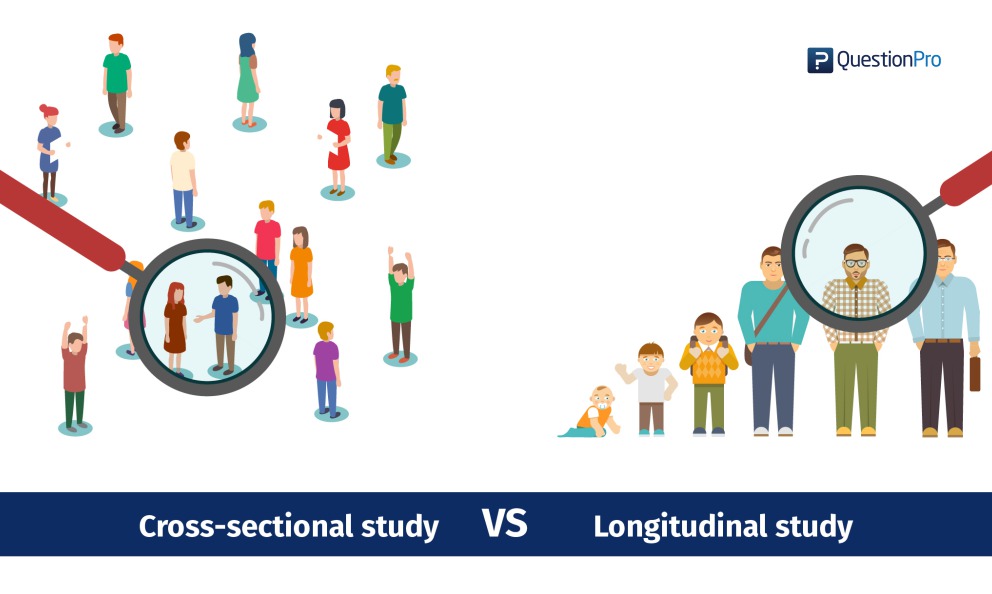
What is Cross-Sectional Study?
Cross-sectional study is defined as an observational research study where data is collected as a whole to study a population at a single point in time to examine the relationship between variables of interest.
- In an observational study, a researcher records information about the participants without changing anything or manipulating the natural environment in which they exist.
- The most important feature of a cross-sectional study is that it can compare different samples at one given point in time. For example, a researcher wants to understand the relationship between joggers and level of cholesterol, he/she might want to choose two age groups of daily joggers, one group is below 30 but more than 20 and the other, above 30 but below 40 and compare these to cholesterol levels amongst non-joggers in the same age categories.
- The researcher at this point in time can create subsets for gender, but cannot consider past cholesterol levels as this would be outside the given parameters for cross-sectional studies.
- Cross-sectional studies allow the study of many variables at a given time. Researchers can look at age, gender, income etc in relation to jogging and cholesterol at a very little or no additional cost involved.
- However, there is one downside to cross-sectional study, this type of study is not able to provide a definitive relation between cause and effect relation (a cause and effect relationship is one where one action (cause) makes another event happen (effect), for example, without an alarm, you might oversleep.)
- This is majorly because cross-sectional study offers a snapshot of a single moment in time, this study doesn’t consider what happens before or after. Therefore in this example stated above it is difficult to know if the daily joggers had low cholesterol levels before taking up jogging or if the activity helped them to reduce cholesterol levels that were previously high.
LEARN ABOUT: Causal Research
What is Longitudinal Study?
Longitudinal study, like the cross-sectional study, is also an observational study, in which data is gathered from the same sample repeatedly over an extended period of time. Longitudinal study can last from a few years to even decades depending on what kind of information needs to be obtained.
- The benefit of conducting longitudinal study is that researchers can make notes of the changes, make observations and detect any changes in the characteristics of their participants. One of the important aspects here is that longitudinal study extends beyond a single frame in time. As a result, they can establish a proper sequence of the events occurred.
- Continuing with the example, in longitudinal study a researcher wishes to look at the changes in cholesterol level in women above the age of 30 but below 40 years who have jogged regularly over the last 10 years. In longitudinal study setup, it would be possible to account for cholesterol levels at the start of the jogging regime, therefore longitudinal studies are more likely to suggest a cause-and-effect relationship.
- Overall, research should drive the design, however, sometimes as the research design progresses it helps determine which of the design is more appropriate. Cross-sectional studies can be done more quickly as compared to longitudinal studies. That’s why a researcher may start off with cross-sectional study and if needed follow it up with longitudinal studies.
LEARN ABOUT: Action Research
Differences between Cross-Sectional Study and Longitudinal Study
Cross-sectional and longitudinal study both are types of observational study, where the participants are observed in their natural environment. There are no alteration or changes in the environment in which the participants exist.
Despite this marked similarity, there are distinctive differences between both these forms of study. Let us analyze the differences between cross-sectional study and longitudinal study.
|
Cross-sectional study |
Longitudinal study |
| Cross-sectional studies are quick to conduct as compared to longitudinal studies. | Longitudinal studies may vary from a few years to even decades. |
| A cross-sectional study is conducted at a given point in time. | A longitudinal study requires a researcher to revisit participants of the study at proper intervals. |
| Cross-sectional study is conducted with different samples. | Longitudinal study is conducted with the same sample over the years. |
| Cross-sectional studies cannot pin down cause-and-effect relationship. | Longitudinal study can justify cause-and-effect relationship. |
| Multiple variables can be studied at a single point in time. | Only one variable is considered to conduct the study. |
| Cross-sectional study is comparatively cheaper. | Since the study goes on for years longitudinal study tends to get expensive. |
LEARN MORE: Population vs Sample
Conclusion
It is true, study design greatly depends on the nature of research questions. Whenever a researcher decides to collect data by deploying surveys to his/her participants, what matters the most are the survey questions that are placed tactfully, so as to gather meaningful insights.
In other words, to know what kind of information a study should be able to collect is the first step in determining how to carry out the rest of the study. What steps need to be included and what can be given a pass.
Continuing from the example above, a researcher wants to establish a relation between the variables, “jogging” and “cholesterol” in this case, one of the first things that a researcher would need to establish in this kind of study is, to tell the most about the relationship. A few questions to ask would be, whether to compare cholesterol levels among different populations of joggers, non-joggers at the same point in time? Or to measure cholesterol levels in a single population of daily joggers over an extended period of time?
The first approach typically requires a cross-sectional study and the second approach requires a longitudinal study.







